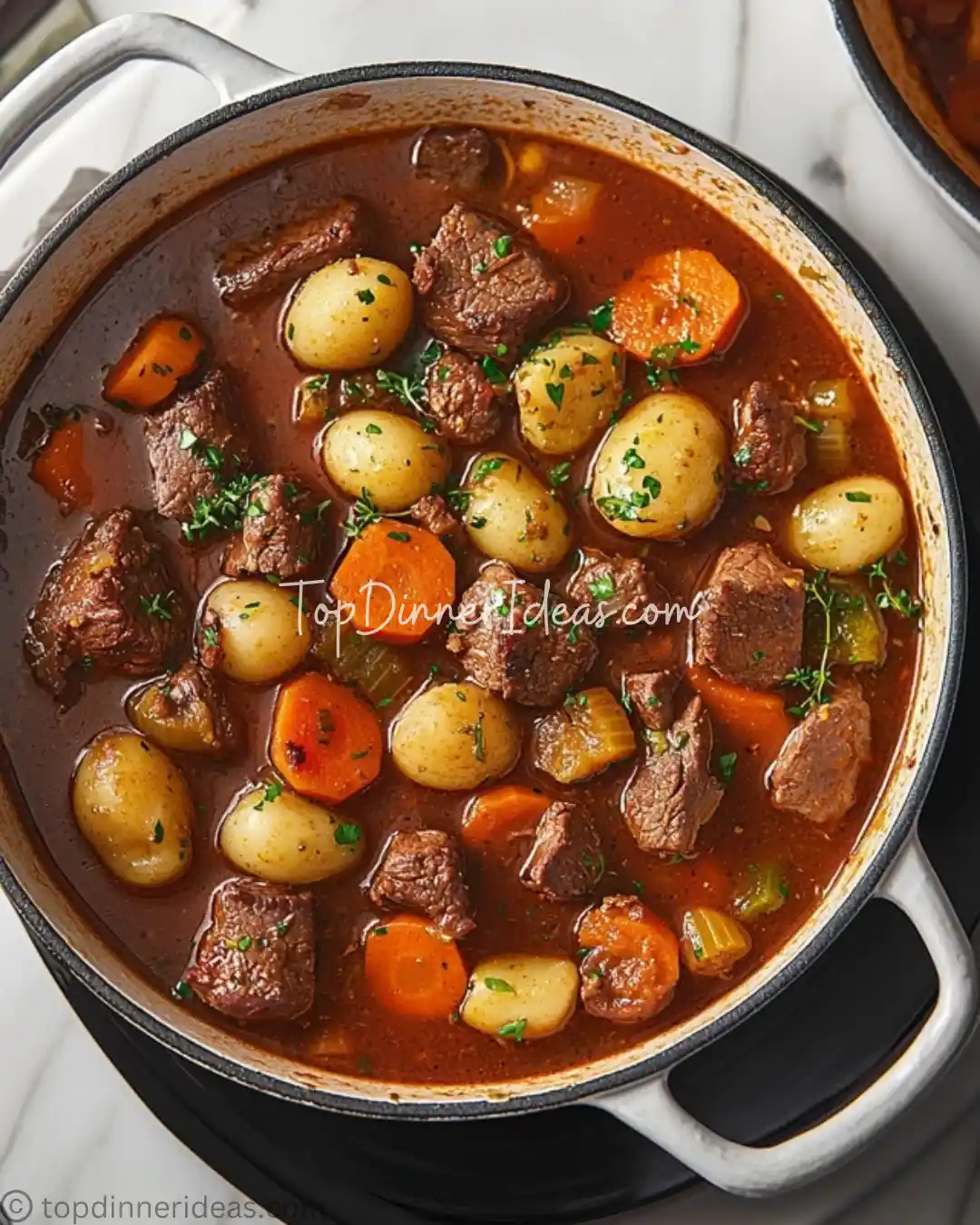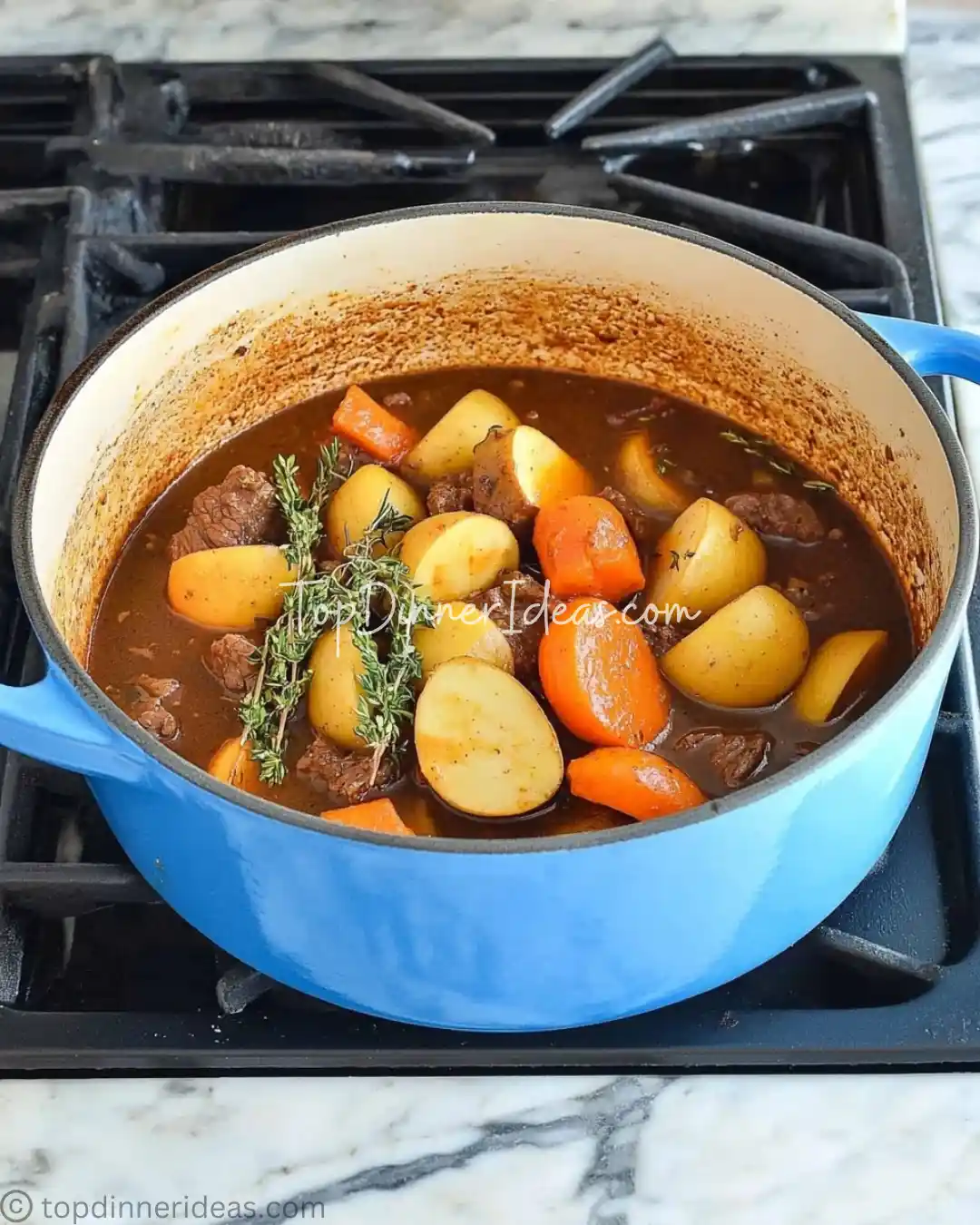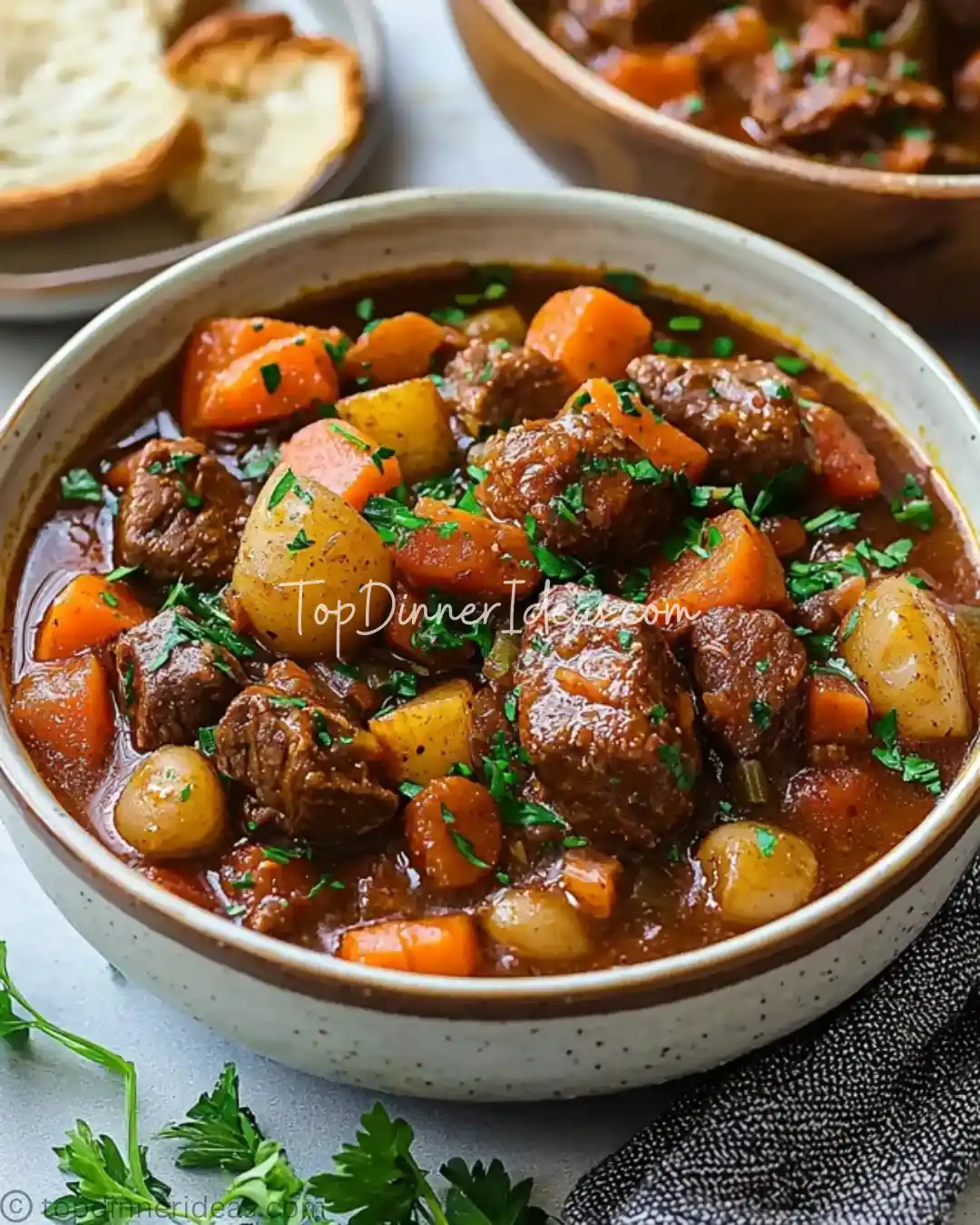Whether you opt for a beef stew prepared in a slow cooker, an Instant Pot beef stew for quicker results, or a stovetop version that develops deep flavors with long simmering, this recipe serves as an outstanding example among beef stew meat recipes and stew meat recipes.
From an easy beef stew recipe that suits busy weeknights to a slow cooker steak stew or even an Irish stew-inspired goulash recipe twist, every method guarantees a delicious and hearty beef stew meal that’s perfect for any occasion.

For me, a good beef stew transcends its humble ingredients by capturing the essence of home-cooked comfort a tender, savory dish that offers layers of flavor with every spoonful, whether enjoyed as a beef stew meal on its own or paired with crusty bread and mashed potatoes.
Ultimately, as you explore this traditional beef stew recipe and its variations from beef stew meat crock pot to an instant pot beef stew you’ll discover a versatile dish that embodies both simplicity and extraordinary taste.
Equipments for
Achieving the perfect Beef Stew Recipe requires the right equipment to ensure even cooking and maximum flavor extraction.
- Large Slow Cooker/Crock Pot: Ideal for low and slow cooking to tenderize beef stew meat.
- Instant Pot or Electric Pressure Cooker: For a faster, equally tender alternative.
- Heavy-Bottomed Dutch Oven or Large Pot: For stovetop simmering and braising.
- Cutting Board and Sharp Knife: For chopping meat and vegetables uniformly.
- Measuring Cups and Spoons: To accurately measure liquids, spices, and broth.
- Wooden Spoon or Ladle: For stirring and serving without damaging the meat.
- Optional: A food processor (if you’d like to puree part of the broth for extra creaminess).
By assembling these essential tools, you’ll be well-equipped to prepare a beef stew that is consistently tender, deeply flavored, and visually appealing no matter which method you choose.
Ingredients for
The ingredients in this beef stew recipe are carefully selected to create a rich, layered flavor profile that transforms simple stew meat into a comforting feast.
For the Beef and Seasoning:
3 lbs beef chuck roast (stew meat), cut into 1 ½-inch cubes – for tender, flavorful meat
Salt and freshly ground black pepper – to taste
2 tsp garlic powder
2 tsp onion powder

For the Vegetable Base:
1 large onion, chopped
3 garlic cloves, minced
3 carrots, peeled and diced
3 celery stalks, diced
2 medium potatoes, peeled and cubed
1 cup frozen peas (optional, added near the end of cooking)
For the Liquid and Broth:
6 cups beef broth (or low-sodium broth)
1 can (14.5 oz) diced tomatoes – with juices
2 tbsp tomato paste – for extra richness
2 bay leaves
1 tsp dried thyme
1 tsp dried oregano
A pinch of red pepper flakes (optional, for subtle heat)
For Finishing (Optional):
2 tbsp Worcestershire sauce – for depth of flavor
Fresh parsley, chopped – for garnish
By combining these ingredients, you establish a hearty foundation for your beef stew recipe that is both robust in flavor and filling enough to serve as a complete, comforting meal.
Instructions to
Follow these detailed step-by-step instructions to create a Beef Stew Recipe that is tender, flavorful, and deeply satisfying perfect for a traditional, slow cooker, Instant Pot, or stovetop preparation.
Prep and Season the Beef:
– Season the beef cubes generously with salt, pepper, garlic powder, and onion powder.
– (Optional) For extra flavor, heat a bit of oil in a large Dutch oven or heavy-bottomed pot over medium-high heat and brown the beef cubes in batches until all sides are caramelized. Remove and set aside.

Sauté the Vegetables:
– In the same pot, add chopped onions, garlic, carrots, and celery. Sauté for about 5 minutes until softened and aromatic.
– If not browning the beef, you can add the raw beef directly after sautéing the vegetables.

Build the Broth:
– Stir in the tomato paste and cook for 1 minute to deepen the flavor.
– Add the diced tomatoes (with juices) and pour in the beef broth.
– Add the bay leaves, dried thyme, dried oregano, and red pepper flakes. Stir to combine.
– Return the beef to the pot along with any accumulated juices.
– Add cubed potatoes and, if using, Worcestershire sauce.

Cooking Methods:
Slow Cooker/Crock Pot:
– Transfer the mixture to a slow cooker, cover, and cook on low for 8 hours or on high for 4–5 hours until the beef is fork-tender.
Instant Pot/Pressure Cooker:
– Secure the lid on the Instant Pot and set it to “Pressure Cook” on high for 35 minutes. Allow a natural pressure release for 10–15 minutes before venting any remaining steam.
Stovetop:
– Bring the mixture to a boil, then reduce the heat to a simmer. Cover and cook for about 2–2.5 hours, stirring occasionally, until the beef and vegetables are tender.

Final Adjustments:
– If you desire a thicker stew, simmer uncovered for an additional 10–15 minutes.
– Adjust the seasoning with additional salt, pepper, or a dash more Worcestershire sauce as needed.
– (Optional) Stir in the frozen peas during the last 5 minutes of cooking to heat through without overcooking.
Serve:
– Discard the bay leaves.
– Ladle the stew into bowls and garnish with freshly chopped parsley.
– Serve hot on its own or with a side of crusty bread for dipping.
By following these comprehensive instructions, you’ll create a beef stew that is rich, hearty, and full of layered flavors an ideal recipe for a comforting meal that can be adapted to your preferred cooking method.
Allergen Information for
Please review the following allergen details to ensure this beef stew recipe meets any dietary requirements of those you are serving.
- Beef: Contains beef; not suitable for those with meat allergies.
- Gluten: Naturally gluten-free if using gluten-free broth and tomato products; verify labels as needed.
- Other: Check that your seasonings and any Worcestershire sauce are free from additives if you have specific allergen concerns.
By considering these allergen details, you can modify the recipe as necessary to ensure that your beef stew is safe and enjoyable for everyone at the table.
Substitutions for
This versatile beef stew recipe is adaptable, allowing you to make substitutions that align with your dietary preferences and ingredient availability.
- Protein: Replace beef stew meat with pork shoulder, lamb stew meat, or even use a plant-based meat alternative for a vegetarian twist.
- Broth: Substitute beef broth with chicken or vegetable broth to alter the flavor profile.
- Vegetables: Add or swap in other vegetables such as parsnips, turnips, or green beans.
- Thickener: If you prefer a thicker stew, stir in a slurry of cornstarch and water during the last 15 minutes of cooking.
- Cooking Method: Use a slow cooker for a more hands-off approach or adapt the recipe for an Instant Pot if you’re short on time.
By embracing these substitutions, you can tailor your beef stew to your particular tastes while maintaining its rich, comforting qualities.
Variations of
Enhance your Beef Stew Recipe by exploring these creative variations to add personal flair or tweak the recipe for different meal occasions.
- Irish Stew Variation: Incorporate a bit of Guinness or stout beer into the broth and add extra root vegetables for a distinct Irish twist.
- Goulash-Inspired: Mix in paprika, caraway seeds, and diced bell peppers for a Central European flavor profile reminiscent of goulash.
- Crock Pot Classic: Prepare the stew in a crock pot for a melt-in-your-mouth texture and minimal hands-on time.
- Instant Pot Beef Stew: Utilize an Instant Pot for a quick yet tender version that retains all the rich flavors.
- Hearty Bean Addition: Stir in a can of white beans for additional protein and fiber, transforming it into a beef and bean stew.
- Spicy Kick: Add a dash of hot sauce or additional red pepper flakes for a spicier variation.
These variations allow you to reinvent the classic beef stew recipe to suit different palates and occasions while remaining true to its comforting, hearty character.
Notes on
Keep these helpful notes in mind as you make your Beef Stew Recipe to ensure optimal flavor and texture throughout the process.
- For best results, brown the beef in batches to avoid steaming and to build rich flavor through caramelization.
- Consistent stirring during simmering helps release the rice’s natural starches (if used in a variant) and prevents sticking.
- Allowing the stew to rest for a few minutes after cooking helps the flavors meld and the meat to reabsorb its juices.
- Taste and adjust seasoning towards the end of cooking; remember that flavors often develop further as the stew sits.
- The stew often tastes even better the following day, making it ideal for leftovers.
By following these notes, you’ll ensure that your Beef Stew Recipe is deliciously tender, perfectly seasoned, and full of heartwarming richness ideal for a comforting family meal.

Health Benefits of
This beef stew recipe not only delivers comforting flavors but also provides several nutritional benefits when included as part of a balanced diet.
- Beef: Offers high-quality protein, iron, and B vitamins essential for energy and muscle repair.
- Vegetables: A medley of carrots, celery, onions, and potatoes provides vitamins, fiber, and antioxidants.
- Broth: A flavorful base that contributes essential minerals and hydration without excessive calories.
- Herbs: Dried thyme and oregano deliver antioxidants and add depth of flavor without extra calories.
By combining these nutrient-dense ingredients, your beef stew serves as a satisfying, nutritious meal that supports overall health while delighting the taste buds.
Nutrition Information
Here’s an approximate nutritional overview per serving to provide insight into how this Beef Stew Recipe contributes to a balanced meal.
- Calories: 450–500 kcal
- Protein: 35–40 g
- Carbohydrates: 30–35 g (including fiber: 4–6 g)
- Fats: 18–22 g
- Vitamins & Minerals: Rich in vitamin A, vitamin C, iron, and potassium
This nutritional breakdown ensures that each serving of your Beef Stew Recipe offers a balanced mix of macronutrients and essential vitamins, making it an excellent choice for a hearty, healthy meal.
Nutritional values can vary based on specific ingredient brands and measurements used. For more precise information, refer to the labels of your chosen ingredients.
Cooking Tips for
These practical cooking tips will help you perfect your Beef Stew Recipe, ensuring that each stage from browning the meat to simmering the vegetables results in a dish that is both flavorful and tender.
- Brown meat in small batches to develop a deep, caramelized flavor.
- Keep the broth at a gentle simmer for even, gradual cooking.
- Stir the stew occasionally to prevent ingredients from sticking to the bottom.
- Adjust liquid levels gradually add more broth if the stew is too thick, or simmer uncovered to reduce if too thin.
- Taste periodically and adjust seasonings toward the end of cooking.
- If using an Instant Pot, allow for a natural pressure release to maintain the meat’s tenderness.
By following these tips, you’ll consistently achieve a Beef Stew Recipe that is rich, hearty, and perfectly balanced in flavor and texture.
Storage Advice for
Proper storage techniques ensure that your Beef Stew Recipe maintains its delicious flavor and hearty texture for future meals.
- Refrigeration: Store leftovers in an airtight container in the refrigerator for up to 3 days.
- Reheating: Gently reheat on the stovetop over low heat, stirring occasionally to evenly warm the stew.
- Freezing: For longer storage, freeze portions in freezer-safe containers for up to 2 months; thaw in the refrigerator overnight before reheating.
- Labeling: Clearly mark containers with the preparation date to ensure freshness is maintained.
Following these storage tips will allow you to enjoy your Beef Stew Recipe as delicious leftovers while preserving its robust flavors and tender texture.

Serving Suggestions for
Enhance your beef stew meal with serving suggestions that turn it into a complete, satisfying dining experience.
- Crusty Bread: Serve with warm, crusty bread or a baguette to scoop up the savory broth.
- Mashed Potatoes: Spoon the stew over creamy mashed potatoes for added comfort.
- Rice: Serve over a bed of steamed rice for extra heartiness.
- Salad: Pair with a fresh garden salad tossed in a light vinaigrette to balance the rich stew.
- Pasta: Enjoy the stew over egg noodles for a fusion twist.
- Side Vegetables: Serve alongside steamed or roasted green beans or broccoli for added nutrition.
With these serving suggestions, your beef stew transforms into a well-rounded meal that’s as comforting as it is delicious, perfect for family dinners and gatherings.
Troubleshooting
If you encounter any issues during the preparation of your beef stew, use these troubleshooting tips to keep your dish on track for optimal flavor and texture.
- Issue: Beef isn’t tender enough.
Solution: Ensure you cook the stew on low heat for the full recommended time, and consider extending the cooking time if necessary. - Issue: Vegetables are overcooked.
Solution: Add vegetables at staggered intervals so that firmer vegetables (like potatoes) have enough time to cook without mushiness. - Issue: The stew is too thick.
Solution: Gradually stir in extra warm broth or water until you reach the desired consistency. - Issue: The stew is too thin.
Solution: Simmer uncovered to reduce excess liquid. - Issue: Flavors are bland.
Solution: Adjust seasonings at the end of cooking, adding a splash of Worcestershire sauce, extra herbs, or a squeeze of lemon juice to brighten the dish.
By applying these troubleshooting techniques, you can overcome any minor setbacks and ensure your beef stew is consistently tender, flavorful, and perfectly balanced.
FAQ About
Beef chuck roast is ideal due to its rich flavor and ability to become tender with slow cooking.
Yes, use the “Pressure Cook” mode for approximately 35 minutes, followed by a natural release.
For stovetop or slow cooker methods, simmer for 2–2.5 hours until the beef is fork-tender.
Yes, browning the beef enhances flavor and adds depth to the finished stew.
Absolutely; feel free to add bell peppers, parsnips, or green beans.
Yes, provided that all ingredients (such as broth and tomato products) are verified gluten-free.
Add extra broth if too thick, or simmer uncovered to reduce if too thin.
Yes, refrigerate for up to 3 days or freeze for up to 2 months; reheat gently on the stovetop.
Certainly; combine all ingredients in a slow cooker and cook on low for 8 hours or on high for 4–5 hours.
Crusty bread, mashed potatoes, or a fresh salad make excellent pairings.
By addressing these frequently asked questions, you’ll have all the essential information needed to prepare a Beef Stew Recipe that is both hearty and delicious, making it a perfect meal for any occasion.
Footnotes for
In conclusion, this beef stew recipe is a celebration of hearty comfort food that transforms quality stew meat, fresh vegetables, and a rich, savory broth into a meal that’s both nourishing and satisfying.
Whether you choose the slow cooker for a hands-off, tender result, the Instant Pot for rapid cooking, or a stovetop method for a classic approach, every step is designed to extract deep flavor and create melt-in-your-mouth beef.
Embrace the flexibility of this recipe from traditional Irish stew to modern beef stew meat recipes and enjoy a delicious bowl of beef stew slow cooker that warms the heart and satisfies the appetite.
For more inventive recipes and culinary inspiration, Navigate to our Main Dishes section, or visit Trustedrecipe, www.spendwithpennies.com or explore additional ideas on Food Network. Thank you for choosing this recipe may every spoonful bring comfort, joy, and a taste of home to your table!



